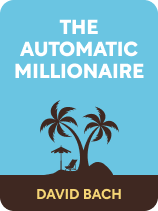

This article is an excerpt from the Shortform book guide to "The Automatic Millionaire" by David Bach. Shortform has the world's best summaries and analyses of books you should be reading.
Like this article? Sign up for a free trial here .
What is The Automatic Millionaire about? What is the key premise behind Bach’s Automatic Millionaire process?
In his book The Automatic Millionaire, David Bach provides a simple yet powerful plan to quickly grow and automate your finances. He argues that financial freedom doesn’t come from how much you earn, but how you manage your earnings—if you’re not saving your money with your current income, you’re unlikely to save it in the future.
Here is a quick overview of the book’s key ideas.
The Automatic Millionaire by David Bach
Bach believes that we struggle to save simply because we’re tempted to spend all of our money before we get a chance to save.
- Decision paralysis: When they’re presented with too many options for how to save, they feel too overwhelmed to make a decision.
- Blaming the system: They choose to focus on economic disadvantages that they can’t control. For example, they believe that those born into privilege have more financial advantages than they do. Sethi advises you to switch your focus and start taking small proactive steps towards financial success.
In his book The Automatic Millionaire, David Bach teaches you how to make smart financial decisions, automate your finances, and build your wealth using only a few dollars a day.
You Can Save More Than You Think
If you’re wondering if you can spare a few dollars every day, this first step of the process will help you to examine and understand how much money you’re currently wasting and the savings you’re missing out on.
Track Your Expenses
Bach claims that we all waste money on small expenses that add up over time. For example, a Netflix subscription might seem like a small expense because you’re only paying $8.99 a month, but it adds up to $107.88 per year.
The sooner you identify your unnecessary expenses, the sooner you can eliminate them and put the money you save towards building long-term wealth. Bach suggests the following exercise: Track all of your expenses over the next few days and identify where you’re spending your money. Once you’ve collated all of your expenses, consider if there are any expenses that you can cut out or reduce.
Automate Your Savings
The core principle of the automated path to wealth is that you must automate your savings and investments to ensure financial success—the more you automate your finances, the more likely you are to grow your wealth because you won’t have to rely on willpower and discipline to avoid wasteful spending.
Bach explains that the only way to improve your financial security is to arrange to automatically save 10-15% of your income before you even have a chance to spend it. He claims that you’ll quickly get used to living without this money, and you won’t need to rely on sticking to a budget to build your financial security.
(Shortform note: Dan Ariely, behavioral economist and author of Predictably Irrational offers clarity on why you’re more likely to achieve financial security by automating your finances. His research reveals that you’re more likely to make irrational spending decisions when you feel emotional—you see something you really want and feel an emotional urge to possess it. This is because your emotional side overpowers your rational side, and you’re less able to think about the consequences of your decisions. Automating your finances eliminates this possibility: Your emotional side can’t “commandeer” money that’s automatically managed.)
How Compound Interest Grows Your Money
Bach argues that putting a few dollars aside every day by itself won’t make you a millionaire, but investing those dollars in the right type of account will. When you invest your money in an account that pays compound interest, you leverage your money—that is, you use it to generate further income in the form of interest payments. For example, if you invest your money in an account that pays you 10% annual interest, this means that you’ll receive an extra 10% of what you invested after one year: Invest $100 and after a year, your money will be worth $110.
Thanks to compound interest, the interest you earn also earns interest—the $110 after another year will be worth $121 ($110 + 10%). The more money you continue to add to this account, the more interest you’ll earn. This is how compound interest transforms small, consistent amounts of money into free money over the course of time.
(Shortform note: Calculating compound interest as Bach suggests can seem daunting if you’re not mathematically-minded. Use a compound calculator to figure out how much money you could earn from the small, wasteful expenses you chose to cut earlier in this chapter.)
Decide on Your Retirement Plan
The next step in Bach’s automated path to wealth is deciding on your retirement plan, where you’ll benefit most from compound interest—the earlier you invest, the more your money will grow, and the better off you’ll be once you stop working.
Use a Tax-Deferred Retirement Plan
Bach argues that you need to contribute to your retirement account before you pay your taxes to make the most out of your income. This is because the government takes approximately 30 cents per dollar of your salary as tax before the money is even sent to your checking account. This means that if you intend to contribute 10% of your income towards your retirement, the amount you end up contributing after you pay your taxes is considerably lower than the amount you’d contribute before you pay your taxes.
You can legally bypass the government’s taxation to maximize the earning potential of your retirement fund and get the most out of your earned dollars by using a tax-deferred retirement plan—a plan that allows you to send money to your retirement account without having to pay tax on it.
Bach suggests various retirement plans depending on whether you’re employed by a company, or self-employed.
If Your Employer Offers Self-Directed Retirement Accounts
There are two types of self-directed retirement accounts your employer might offer: 401(k) and 403(b). According to Bach, one out of every four American workers don’t sign up for the retirement accounts their companies offer—he claims that most people just assume that they’re automatically signed up to benefit from their company’s retirement plan.
(Shortform note: Bach mentions that people often don’t enroll in their company’s retirement plans, but he doesn’t offer in-depth explanations for why this reluctance exists. According to some psychologists, one reason we avoid planning for our retirement is that we find it difficult to imagine ourselves getting older—while we understand that old age is inevitable, the concept doesn’t feel real. As a result, we’re more inclined to seek gratification here and now than save for our future needs.)
If You Need to Open an Individual Retirement Account
If your employer doesn’t offer self-directed retirement accounts, you’ll need to open an Individual Retirement Account (IRA). You can choose from one of three options: the Traditional IRA, the Roth IRA, or the Roth 401(k), which is similar to the Roth IRA but allows you to contribute more each year. The difference between the Traditional IRA and the Roth IRAs is when you pay tax on your retirement money: when you withdraw money in the case of the Traditional IRA, and when you contribute in the case of the Roth IRAs. This means that the Traditional IRA has the benefit of allowing you to contribute more money upfront, as it won’t be taxed; meanwhile, the Roth IRAs provide tax-free income after you retire.
If You’re Self-Employed
Business owners can take advantage of many different types of retirement accounts and benefit from many tax breaks. Bach claims that the simplest options to choose from are: the Simplified Employee Pension (SEP-IRA) and the One-Person 401(k) Profit Sharing Account, otherwise known as the “Solo 401(k)”.
(Shortform note: Bach briefly explains the benefits of both plans, but doesn’t elaborate on some details needed to make an informed decision about which to choose. For example, he doesn’t mention that the SEP IRA has no catch-up contributions—employees aged over 50 cannot make additional contributions. Furthermore, Bach claims that you can qualify for the One-Person 401(k) plan if you only have family members working for you. However, that’s not the case. You can qualify for this plan if you don’t have employees or if your spouse is your only employee.)
Investment Options for Your Retirement Account
Once you’ve chosen your retirement account, you’ll need to select investment options that determine how your money will grow—retirement accounts can only earn interest on and grow your money if that money is invested into stocks and bonds. As we’ll see, these options will cover how long you intend to invest your money, and how aggressively you want to invest.
Diversify Your Investments
Bach explains that to ensure that you get the best return from your retirement plan, you need to diversify your investments—this means that you need to invest your money in a combination of cash, bonds, and stocks. The more diversified your investments, the safer your money—stocks may lose their value, but if your money is diversified, the overall value of your plan will stay consistent. However, the safer your investments, the less likely you are to make money on your plan.
Build a Safety Net
Bach recommends that you build a safety net—a savings account with money you can use for emergencies. Bach states that the average American has less than three months’ worth of expenses saved—these people are financially unprepared for the bad, unexpected things that could happen such as isolating at home and quitting work due to a pandemic.
(Shortform note: In addition to a safety net to see you through hard times, many experts argue that you should also invest in health insurance to ensure that you’re covered for unexpected medical costs.)
Bach outlines two steps to create your safety net: assess how prepared you are and grow your savings.
Assess How Prepared You Are
Bach explains that financially secure people aim to save at least 3 to 24 months’ worth of savings. To figure how many months you could survive on your current savings, divide the amount of money you have saved by the sum of your monthly expenses.
(Shortform note: Bach doesn’t explain how to accommodate irregular salaries—income that varies from month to month. Sethi suggests that, in addition to your savings accounts, you also set aside three to six months’ worth of living expenses to cover you during the months when your income doesn’t cover all of your expenses. This way, you can simulate a stable income and you won’t have to dip into your savings accounts to cover your expenses during low-income months.)
Grow Your Savings
Bach recommends that you keep your emergency savings separate from your checking account so that you’re not tempted to spend the money. Further, he advises that you invest the money in high-yield savings accounts so that it can earn interest and grow.
(Shortform note: Bach’s process focuses on creating a single savings account and doesn’t accommodate the large expenses you’ll have outside of unexpected emergencies. In contrast, in The Barefoot Investor, Pape recommends that you allocate a percentage of your money to a “happy” savings account—an account used for large expenses that you want to save up for such as a holiday or a car, and a “grow” savings account—an account for long-term investments and savings goals. This way, you don’t need to dip into your long-term savings accounts to fund your large expenses.)
Clear Your Debts
Bach argues that, if you’re in debt, you should prioritize clearing the amount before you build your savings account. This is because the interest you earn in your savings account is far less than the interest you pay towards your debts. To clarify, if you owe $2,000 in credit card debt and just make the minimum monthly payments, it will take you more than 18 years, and a total of $4,600 to pay off your balance. The same $2,000 held in a savings account earning 1% will only total $2,392.29 after 18 years. Therefore, you’ll save far more money if you clear your debts first.
(Shortform note: It’s true that clearing debts before you build your safety net will save you more money in the long term. However, if your job situation is insecure, some financial experts advise that you should prioritize your savings before you clear your debts. This way, you’ll avoid getting into further debt if you do lose your job—you won’t have to rely on your credit cards to survive because you’ll have savings to fall back on.)
Your Debt-Clearing Plan
We’ve broken the process down into four distinct steps: total up your balances and interest, make commitments, reduce your payments, and prioritize your debts. (Shortform note: Sethi’s debt-clearance plan differs from Bach’s method and provides some contradictory advice—we’ll compare Sethi’s process to Bach’s throughout each of the four steps.)
Step 1: Total p your balances and interest: If you’re currently in debt, you’ll need to total up the balances you owe and the amount of interest you’re paying on top of this balance.
(Shortform note: Sethi advises that you should call up your credit companies to find out how much debt you owe, how much interest you’re paying, and the minimum monthly payment. He claims that many people are unaware of exactly how much debt they’re in so need to speak to their debtors before they can come up with a plan to clear their debts.)
Step 2: Make commitments: Don’t buy things you can’t afford (property is the only exception as it tends to appreciate in value), and refuse to use credit cards—cancel them and remove the temptation to use them.
(Shortform note: Both Bach and Sethi advise that you don’t buy things you can’t afford, but they differ on what methods you should use to pay for what you buy. In contrast to Bach, Sethi suggests that you keep your credit cards as they’ll improve your credit history—make use of them but always pay your balance off in full. This way, you show lenders you can be trusted to pay back the money you borrow.)
Step 3: Reduce your payments: Contact your credit card company and ask if they can lower the rate of interest you’re paying, or consolidate all of your payments—move multiple debts to a single low-interest account. In addition, automate your payments to avoid paying late fees.
(Shortform note: In addition to consolidating and automating your payments, Sethi argues that you should negotiate lower interest rates regardless of whether you’re in debt or not. This will reduce your chances of getting in debt if you ever fail to pay off your balance.)
Step 4: Prioritize your debts: If you choose not to consolidate your payments, pay off your debts one by one. Bach suggests you divide the balance of each debt by the minimum payment required—this will show you the number of payments you need to make to pay off the debt. Next, rank your debts so that the lowest number of payments is on top. Prioritize paying off the debt at the top of your list while you continue to pay the minimum balance for your remaining debts.
(Shortform note: Sethi also suggests that you commit to paying off one card at a time while using automated payments to pay the minimum balance for the rest of the debts. However, he believes you have two options for doing this: prioritize the cards with the highest interest, or use Dave Ramsey’s “snowball method” to prioritize paying off cards with the lowest balance (regardless of the interest they charge). He advises that you should plan to make more aggressive payments until you clear your debts.)
Own Your Home Outright
According to Bach, the average American homeowner is more than 35 times richer than the average renter. This is because homeowners end up spending less money than renters in the long run. Let’s say you rent an apartment at $1,500 a month over 30 years—at the end of this period you’ll have spent $540,000 and have to continue to pay rent. On the other hand, if you buy a house and you pay $1,500 on your mortgage for 30 years, at the end of this period you’ll own your own home (no more payments) and be free of debt.
In addition, buying a home will also provide financial security in the form of equity—over the long term, the value of real estate investments always increases (the average annual return since 1968 is 5.3%).
Bach suggests you follow three steps to buy a house: pay your down payment, choose the right mortgage payment plan, and accelerate your mortgage payments.
Step 1: Pay Your Down Payment
The main reason that people don’t buy a home is that they think they need to pay thousands of dollars upfront to get a mortgage. Bach argues that these people are wrong—there are many programs designed to enable first-time homebuyers to finance up to 100% of the down payment for the home they want to purchase. Bach suggests that you research housing finance agencies if you need help putting together a down payment.
(Shortform note: Bach doesn’t provide information regarding why companies would offer to provide you with a loan for a deposit, and it’s unclear whether these loans would incur additional costs or have strings attached—such as whether you’ll be restricted to buy specific types of houses or limited by location.)
Choose the Right Mortgage Payment Plan
Bach claims that you should be able to spend between 29-41% of your gross income on housing expenses—which include your mortgage, taxes, and insurance. Aim for the minimum if you still have debts to clear and more if you don’t have any debts to pay off.
(Shortform note: In addition to Bach’s suggestions, Pape claims that it’s crucial to also factor lifestyle changes into your housing expenses before you decide to buy a house. For example, if you have children, your expenses will increase significantly—you’ll either have to pay for childcare or reduce your working hours to care for the children, and this will impact your ability to keep up with mortgage payments.)
Accelerate Your Mortgage Payments and Build Your Equity Fast
Overall, Bach recommends fixed-rate mortgages, as he believes these have the most benefits. However, he notes that a drawback of these plans is that you’ll end up paying a huge amount of interest over the full mortgage term (and at the beginning of the term, you’ll pay mostly interest, accruing minimal equity in your home).
However, he insists that you can avoid the disadvantages of fixed plans if you accelerate your mortgage payments: in other words, pay more towards your mortgage each month or year than you need to. This enables you to cut years off your payment plan, thus reducing the amount of interest you pay in total (since interest accrues exponentially over time—cut the time spent paying your mortgage, and you cut the amount of interest you pay).
Pay It Forward
Bach insists that the point of building wealth is not just to have more money, but to use the money to do things that make you feel good. He suggests donating a portion of your income to a cause you care about—not only will you feel good about yourself, but you’ll also actually feel wealthier and your pursuit of money will feel more meaningful.
(Shortform note: In addition to making your pursuit of wealth more meaningful, philanthropy helps define your legacy. Pape (Barefoot Investor) claims that, after you’re gone, people are only going to remember you for the contribution you made to the world, not for the amount of money and material things you possessed. Along with donating money, Pape suggests that you could use your money to create your own charitable organization, or to fund a product or service to help your community.)
Choose Your Recipient and Automate Your Donations
Bach suggests that you research and identify charities that are meaningful to you. Once you’ve chosen your cause, your recipient should be able to contact your bank to set up an automatic payment plan on your behalf (with your permission) so that you can make regular monthly contributions.
Bach urges you to keep track of your donations—many charitable donations are tax-deductible so you may save taxes on your contributions (if you donate $100, you can claim back the tax you’ve paid for that $100 on your tax return). You can check with the IRS and request #526 (Charitable Contributions) to confirm whether your chosen charity is tax-exempt.

———End of Preview———
Like what you just read? Read the rest of the world's best book summary and analysis of David Bach's "The Automatic Millionaire" at Shortform .
Here's what you'll find in our full The Automatic Millionaire summary :
- A simple but powerful action plan for you to quickly automate your finances
- How to grow your finances with just a few dollars a day
- An exploration of why people fail to prepare for their financial futures






